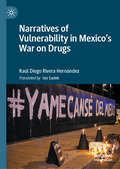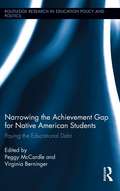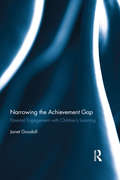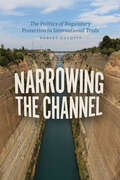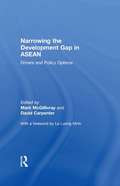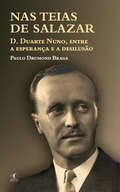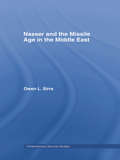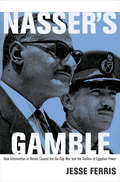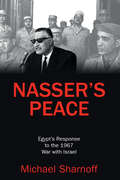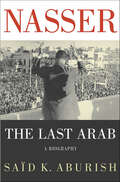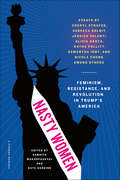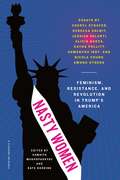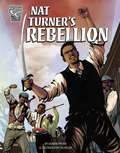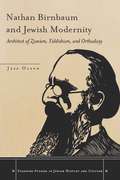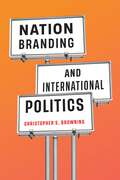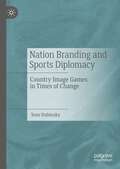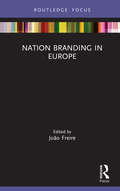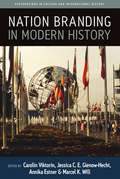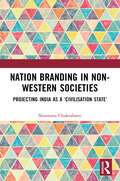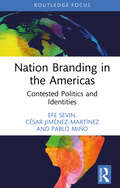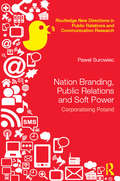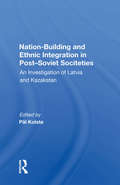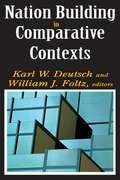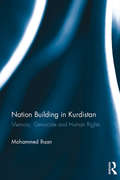- Table View
- List View
Narratives of Vulnerability in Mexico's War on Drugs
by Raúl Diego Rivera HernándezThis book explores the current human rights crisis created by the War on Drugs in Mexico. It focuses on three vulnerable communities that have felt the impacts of this war firsthand: undocumented Central American migrants in transit to the United States, journalists who report on violence in highly dangerous regions, and the mourning relatives of victims of severe crimes, who take collective action by participating in human rights investigations and searching for their missing loved ones. Analyzing contemporary novels, journalistic chronicles, testimonial works, and documentaries, the book reveals the political potential of these communities’ vulnerability and victimization portrayed in these fictional and non-fictional representations. Violence against migrants, journalists, and activists reveals an array of human rights violations affecting the right to safe transit across borders, freedom of expression, the right to information, and the right to truth and justice.
Narrowing the Achievement Gap for Native American Students: Paying the Educational Debt (Routledge Research in Education Policy and Politics #6)
by Peggy McCardle Virginia BerningerThere has been much talk and effort focused on the educational achievement gap between white versus black, Hispanic and American Indian students. While there has been some movement the gap has not appreciably narrowed, and it has narrowed the least for Native American students. This volume addresses this disparity by melding evidence-based instruction with culturally sensitive materials and approaches, outlining how we as educators and scientists can pay the educational debt we owe our children. In the tradition of the Native American authors who also contribute to it, this volume will be a series of "stories" that will reveal how the authors have built upon research evidence and linked it with their knowledge of history and culture to develop curricula, materials and methods for instruction of not only Native American students, but of all students. It provides a framework for educators to promote cultural awareness and honor the cultures and traditions that too few people know about. After each major section of the volume, the editors will provide commentary that will give an overview of these chapters and how they model approaches and activities that can be applied to other minority populations, including Blacks, Hispanics, and minority and indigenous groups in nations around the globe.
Narrowing the Achievement Gap: Parental Engagement with Children’s Learning (Routledge Research in Education)
by Janet GoodallNarrowing the Achievement Gap proposes a radical change to our conception of learning, education and schooling, arguing that parental engagement is the best lever we have for school improvement and closing the achievement gap. Unique in its focus on original research linking underachievement and parental engagement, this book uses a range of international case studies to demonstrate that achievement isn’t only reliant on what happens in school and that what happens out of school is equally important. Each chapter explores how schools can actively engage with parents and communities to reinstate education in the home, and to generate support to combat issues out of their control, including poverty, deprivation, and a lack of social capital. Although schools have an integral part to play in this process, it argues that parents and society must reconsider their own educational responsibility, regardless of background, and offers a solid research base and practical suggestions to help do so. Consisting of an in-depth and contemporary study of this significant issue in educational achievement and written by an expert in the field, this text will appeal to researchers, academics and postgraduate students in the fields of education, schooling, sociology of education, school effectiveness and improvement, school policy and school leadership.
Narrowing the Channel: The Politics of Regulatory Protection in International Trade (Chicago Series on International and Domestic Institutions)
by Robert GulottyWhile large, multinational corporations have supported the removal of tariffs, behind the scenes these firms have fought for protection in the form of product regulations, including testing, labeling, and registration requirements. Unlike tariffs, these regulations can raise fixed costs, excluding smaller firms from the market and shifting profits toward global giants.Narrowing the Channel demonstrates that globalization and globalized firms can paradoxically hinder rather than foster economic cooperation as larger firms seek to protect their markets through often unnecessarily strict product regulations. To illustrate the problem of regulatory protectionism, Robert Gulotty offers an in-depth analysis of contemporary rulemaking in the United States and the European Union in the areas of health, safety, and environmental standards. He shows how large firms seek regulatory schemes that disproportionately disadvantage small firms. When multinationals are embedded in the local economy, governments too have an incentive to use these regulations to shift profits back home. Today, the key challenge to governing global trade is not how much trade occurs but who is allowed to participate, and this book shows that new rules will be needed to allow governments to widen the benefits of global commerce and avoid further inequality and market concentration.
Narrowing the Development Gap in ASEAN: Drivers and Policy Options
by David Carpenter Mark McGillivrayAn important part of the vision of the Association of Southeast Asian Nations (ASEAN) is to ensure that the benefits of development and economic integration are equitably shared by all member states and their citizens. ASEAN’s work therefore aims to narrow the development gap between ASEAN member states (Indonesia, Malaysia, the Philippines, Singapore, Thailand, Brunei Darussalam, Myanmar, Cambodia, Laos and Vietnam) and between sub-regions within ASEAN. Written by a team of internationally recognised experts in development economics, this book communicates the latest findings on narrowing the development gap in a practical, policy-relevant way, in a format that can influence decision makers within ASEAN member states and international donors. There have been significant development achievements in many ASEAN countries over the last 20 years, but the ASEAN region continues to be characterised by significant development gaps, particularly in income. Gaps in development achievement are also seen at the regional and sub-national levels. This book offers a better understanding of development gaps, as they exist in 2012, and provides important context that can inform the strategic needs of decision makers in the ASEAN region. Due to improvements in conceptualising and measuring well-being, including through the use of multidimensional indicators, this book gives policy makers and scholars in development economics, development policy and Asian studies well-grounded insights into the nature of the development gaps within and between ASEAN countries as well as high-level policy advice on those interventions that can contribute to a narrowing of the development gap.
Nas teias de Salazar: D. Duarte Nuno de Bragança (1907-1976), entre a esperança e a desilusão
by Paulo Drumond BragaA primeira biografia de D. Duarte Nuno de Bragança, o príncipe herdeiro nascido para não reinar. Com testemunhos dos filhos, D. Duarte Pio e Dom Miguel, e fotografias do espólio da família. D. Duarte Nuno (Seebenstein, 23 de setembro de 1907 - Lisboa, 24 de dezembro de 1976), duque de Bragança, foi pretendente ao trono de Portugal durante mais de meio século (1920-1976), mas só a partir de 1932, com a morte de D. Manuel II, congregou em seu torno a quase totalidade dos monárquicos portugueses. Sempre apoiou o Estado Novo, esperando que o regime evoluísse, mais tarde ou mais cedo, para a Monarquia. Salazar soube manobrar com extrema habilidade esta questão, nunca fechando portas, mas, em simultâneo, não dando qualquer passo concreto no sentido desejado por D. Duarte Nuno, que, a partir de dado momento, deve ter perdido toda e qualquer esperança de vir a ser rei. Tudo isso, ligado a outros fatores, como a viuvez (1968) e as incertezas quanto ao futuro no Portugal de 1974-1975, agravou um quadro depressivo a que sempre fora atreito. Morreu aos 69 anos, precocemente envelhecido, jazendo em Vila Viçosa.
Nasser and the Missile Age in the Middle East (Contemporary Security Studies)
by Owen L. SirrsEgyptian efforts to acquire long-range surface-to-surface missiles in the early 1960s carry important lessons for our time, when weapons of mass destruction and charges of politicizing intelligence are key issues. This new study traces the history of the early Egyptian ballistic missile program, which began with the successful recruitment of German scientists who had experience in Hitler’s V1 and V2 missile projects. Yet even as these Germans began their work on developing missiles for Egyptian President Gamal Abdel Nasser, Israeli intelligence was busy collecting information on their activities, sparking a crisis in the Israeli leadership as top Israeli officials anxiously debated strategies to grapple with this new threat to their national security. Ultimately, they adopted a multifaceted approach that included intimidation of the scientists and their families, appeals to the West German government to order the scientists’ recall and an attempt to involve the US government in the intricacies of the Arab-Israeli conflict. Drawing extensively on material from recently declassified US government documents, this new major work demonstrates how Nasser’s missile program played an instrumental role in cementing the US-Israeli national security relationship. The book concludes with several key lessons that can help stem the global proliferation of advanced weapons. This book will be of great interest to scholars of proliferation, international relations, the Middle East, disarmament and security studies in general.
Nasser's Gamble: How Intervention in Yemen Caused the Six-Day War and the Decline of Egyptian Power
by Jesse FerrisNasser's Gamble draws on declassified documents from six countries and original material in Arabic, German, Hebrew, and Russian to present a new understanding of Egypt's disastrous five-year intervention in Yemen, which Egyptian president Gamal Abdel Nasser later referred to as "my Vietnam." Jesse Ferris argues that Nasser's attempt to export the Egyptian revolution to Yemen played a decisive role in destabilizing Egypt's relations with the Cold War powers, tarnishing its image in the Arab world, ruining its economy, and driving its rulers to instigate the fatal series of missteps that led to war with Israel in 1967. Viewing the Six Day War as an unintended consequence of the Saudi-Egyptian struggle over Yemen, Ferris demonstrates that the most important Cold War conflict in the Middle East was not the clash between Israel and its neighbors. It was the inter-Arab struggle between monarchies and republics over power and legitimacy. Egypt's defeat in the "Arab Cold War" set the stage for the rise of Saudi Arabia and political Islam. Bold and provocative, Nasser's Gamble brings to life a critical phase in the modern history of the Middle East. Its compelling analysis of Egypt's fall from power in the 1960s offers new insights into the decline of Arab nationalism, exposing the deep historical roots of the Arab Spring of 2011.
Nasser's Peace: Egypt’s Response to the 1967 War with Israel
by Michael SharnoffGamal Abdel Nasser was arguably one of the most influential Arab leaders in history. As President of Egypt from 1956 to 1970, he could have achieved a peace agreement with Israel, yet he preferred to maintain his unique leadership role by affirming pan-Arab nationalism and championing the liberation of Palestine, a common euphemism for the destruction of Israel. In that era of Cold War politics, Nasser brilliantly played Moscow, Washington, and the United Nations to maximize his bargaining position and sustain his rule without compromising his core beliefs of Arab unity and solidarity. Surprisingly, little analysis is found regarding Nasser’s public and private perspectives on peace in the weeks and months immediately after the 1967 War. Nasser’s Peace is a close examination of how a developing country can rival world powers and how fluid the definition of “peace” can be. Drawing on recently declassified primary sources, Michael Sharnoff thoroughly inspects Nasser’s post-war strategy, which he claims was a four-tiered diplomatic and media effort consisting of his public declarations, his private diplomatic consultations, the Egyptian media’s propaganda machine, and Egyptian diplomatic efforts. Sharnoff reveals that Nasser manipulated each tier masterfully, providing the answers they desired to hear, rather than stating the truth: that he wished to maintain control of his dictatorship and of his foothold in the Arab world.
Nasser: The Last Arab
by Said K. AburishNasser is a definitive and engaging portrait of a man who stood at the center of this continuing clash in the Middle East.Since the death of Egyptian president Gamal Abdel Nasser in 1970 there has been no ideology to capture the imagination of the Arab world except Islamic fundamentalism. Any sense of completely secular Arab states ended with him and what we see today happening in the Middle East is a direct result of Western opposition to Nasser's strategies and ideals.Nasser is a fascinating figure fraught with dilemmas. With the CIA continually trying to undermine him, Nasser threw his lot in with the Soviet Union, even though he was fervently anti-Communist. Nasser wanted to build up a military on par with Israel's, but didn't want either the '56 or '67 wars. This was a man who was a dictator, but also a popular leader with an ideology which appealed to most of the Arab people and bound them together. While he was alive, there was a brief chance of actual Arab unity producing common, honest, and incorruptible governments throughout the region.More than ever, the Arab world is anti-Western and teetering on disaster, and this examination of Nasser's life is tantamount to understanding whether the interests of the West and the Arab world are reconcilable.
Nasty Women: Feminism, Resistance, and Revolution in Trump's America
by Cheryl Strayed Rebecca Solnit“A collection of viewpoints aimed at piercing the fug of misogyny and racism that has held sway after the 2016 election.” —Elle (The Best Books to Read This Fall)When 53 percent of white women voted for Donald Trump and 94 percent of black women voted for Hillary Clinton, how can women unite in Trump’s America? Nasty Women includes inspiring essays from a diverse group of talented women writers who seek to provide a broad look at how we got here and what we need to do to move forward.Featuring essays by REBECCA SOLNIT on Trump and his “misogyny army,” CHERYL STRAYED on grappling with the aftermath of Hillary Clinton’s loss, SARAH HEPOLA on resisting the urge to drink after the election, NICOLE CHUNG on family and friends who support Trump, KATHA POLLITT on the state of reproductive rights and what we do next, JILL FILIPOVIC on Trump’s policies and the life of a young woman in West Africa, SAMANTHA IRBY on racism and living as a queer black woman in rural America, RANDA JARRAR on traveling across the country as a queer Muslim American, SARAH HOLLENBECK on Trump’s cruelty toward the disabled, MEREDITH TALUSAN on feminism and the transgender community, and SARAH JAFFE on the labor movement and active and effective resistance, among others.“With essays from Cheryl Strayed, Alicia Garza, Katha Pollitt, and marieclaire.com contributing editor Jessica Valenti, among others, this collection will keep you fired up for the next three years.” —Marie Claire“An important guide showing what intersectional feminism actually looks like . . . compelling.” —Rewire
Nasty Women: Feminism, Resistance, and Revolution in Trump’s America
by Kate Harding Samhita MukhopadhyayTwenty-Three Leading Feminist Writers on Protest and Solidarity. When 53 percent of white women voted for Donald Trump and 94 percent of black women voted for Hillary Clinton, how can women unite in Trump's America? Nasty Women includes inspiring essays from a diverse group of talented women writers who seek to provide a broad look at how we got here and what we need to do to move forward. Featuring essays byREBECCA SOLNIT on Trump and his "misogyny army,"CHERYL STRAYED on grappling with the aftermath of Hillary Clinton's loss,SARAH HEPOLA on resisting the urge to drink after the election,NICOLE CHUNG on family and friends who support Trump,KATHA POLLITT on the state of reproductive rights and what we do next,JILL FILIPOVIC on Trump's policies and the life of a young woman in West Africa,SAMANTHA IRBYon racism and living as a queer black woman in rural America,RANDA JARRAR on traveling across the country as a queer Muslim American,SARAH HOLLENBECK on Trump's cruelty toward the disabled,MEREDITH TALUSAN on feminism and the transgender community, andSARAH JAFFE on the labor movement and active and effective resistance,among others.
Nat Turner's Rebellion (Movements and Resistance)
by Shawn PryorNat Turner, an enslaved black man, believed he was chosen by God to battle against the evils of slavery. Driven by visions, Turner banded with six others, and on August 22, 1831, his rebellion began with attacks at plantations in Southampton, Virginia. As he and his group moved from plantation to plantation, dozens of enslaved men joined them. Finally, the local militia put an end to their movement, arresting and hanging many of the men involved. Nat Turner’s rebellion deepened the divide between Americans who wanted to abolish slavery and those who wanted to protect it, setting the groundwork for the American Civil War.
Nathan Birnbaum and Jewish Modernity: Architect of Zionism, Yiddishism, and Orthodoxy
by Jess OlsonThis book explores the life and thought of one of the most important but least known figures in early Zionism, Nathan Birnbaum. Now remembered mainly for his coinage of the word "Zionism," Birnbaum was a towering figure in early Jewish nationalism. Because of his unusual intellectual trajectory, however, he has been written out of Jewish history. In the middle of his life, in the depth of World War I, Birnbaum left his venerable position as a secular Jewish nationalist for religious Orthodoxy, an unheard of decision in his time. To the dismay of his former colleagues, he adopted a life of strict religiosity and was embraced as a leader in the young, growing world of Orthodox political activism in the interwar period, one of the most successful and powerful movements in interwar central and eastern Europe. Jess Olson brings to light documents from one of the most complete archives of Jewish nationalism, the Nathan and Solomon Birnbaum Family Archives, including materials previously unknown in the study of Zionism, Yiddish-based Jewish nationalism, and the history of Orthodoxy. This book is an important meditation on the complexities of Jewish political and intellectual life in the most tumultuous period of European Jewish history, especially of the interplay of national, political, and religious identity in the life of one of its most fascinating figures.
Nation Branding and International Politics
by Christopher S. BrowningNation branding is regarded as essential for competitiveness among countries, but the idea of branding nations is often derided as lacking seriousness. While nation branding has been on the radar of scholars of marketing, communication, and media studies, as well as political geography for decades, it has only made a small dent into the international relations field.In Nation Branding and International Politics Christopher Browning argues that international relations should take nation branding seriously. Nation branding not only involves the issues of culture, identity, and status – which are of principal concern to IR – but it is also a different and potentially fruitful way of reconceptualizing statehood. Mobilizing work on ontological security, anxiety, status, and distinction, and grounding the analysis in a broader historical context, Browning finds that nation branding is politically significant, though not necessarily for the reasons its advocates claim. Specifically, the book raises important questions about nation branding’s influence on the constitution of national identity, the reframing of citizenship, and the topography of contemporary geopolitics.Nation Branding and International Politics considers how status, prestige, and reputation are constructed and maintained in international society, and how, perhaps, this construction and maintenance may be changing – just as the practice of nation branding is changing.
Nation Branding and Sports Diplomacy: Country Image Games in Times of Change
by Yoav DubinskyThis book critically discusses the role of sports in nation branding and public diplomacy during the years 2020 and 2022, as the world was going through a global pandemic and health, economic, social, and political crises. The book argues that the use of sports for nation branding and public diplomacy goals is not new, but the changes the world went through required nations, places, communities, and individuals to modify and adapt the ways they use sports for country image purposes. After discussing global changes, the book outlines the theoretical frameworks of nation branding and public diplomacy, and discusses their manifestations through the evolution of the FIFA World Cup, the postponed Tokyo 2020 Olympic Games, the role of Title IX in American sports, the European Super League, the Oregon22 World Athletics Championships, the emergence of sport-tech diplomacy, and though the role of sports and the global order in an ever-changing world.
Nation Branding in Europe (Routledge Focus on Nation Branding)
by João FreireThis book provides an explanation of nation branding theory and practice within the European context, exploring how countries build and manage their reputations globally. Each chapter focuses on a specific European country, selected from a cross-section of large, medium-sized and small countries to provide a breadth of cases from across the continent. The chapters are written from a wide range of academic and practitioner perspectives. Nation Branding in Europe is valuable supplementary reading for advanced undergraduate, postgraduate and doctoral students interested in nation branding and will appeal to students from marketing, communications, and international relations disciplines. Outside of academia, the book will be of interest to those working in the areas of public diplomacy and strategic communications, as well as public relations and branding practitioners involved in designing nation branding campaigns.
Nation Branding in Modern History (Explorations in Culture and International History #9)
by Carolin Viktorin Jessica Gienow-Hecht Annika Estner Marcel K. WillA relatively recent coinage within international relations, “nation branding” designates the process of highlighting a country’s positive characteristics for promotional purposes, using techniques similar to those employed in marketing and public relations. Nation Branding in Modern History takes an innovative approach to illuminating this contested concept, drawing on fascinating case studies in the United States, China, Poland, Suriname, and many other countries, from the nineteenth century to the present. It supplements these empirical contributions with a series of historiographical essays and analyses of key primary documents, making for a rich and multivalent investigation into the nexus of cultural marketing, self-representation, and political power.
Nation Branding in Non-Western Societies: Projecting India as a ‘Civilisation State’
by Shantanu ChakrabartiA country’s stature in global politics is often determined by its popular image and public perceptions, as reflected in global media. While ‘nation branding’ as a term and a tool of analysis in Social Sciences has emerged prominently since the 1990s, the practice of ‘positive’ projection of states, regions and locality along with non-state institutions has deeper historical roots. Apart from nation branding, the cultural turn in ‘International Relations’ has led to popularisation of analytical concepts like ‘soft power’ and ‘civilisation’ or ‘civilisational states.’The present work focuses on two of these concepts: ‘nation branding’ and ‘civilisation state’ and traces the historical process of evolution in Indian nation building project. It analyses the evolving concept of ‘civilisation state’ and its association with the strong urge for autonomy along with the self-perception of national and cultural greatness shared by the Indian elite leading to a search for identity and recognition of the intra-regional and extra-regional linkages in terms of shared cultural and historical identity. It also looks into the process of continuity from independence to present times and to what extent this has influenced Indian elite thinking and conceptualisation of India’s status in global affairs.Print edition not for sale in South Asia (India, Sri Lanka, Nepal, Bangladesh, Pakistan and Bhutan)
Nation Branding in the Americas: Contested Politics and Identities (Routledge Focus on Nation Branding)
by Efe Sevin César Jiménez-MartÍnez Pablo MiñoNation Branding in the Americas: Contested Politics and Identities provides an overview of nation branding in the Americas, an often neglected continent(s) in debates about the creation, dissemination and management of national images.Drawing on insights from promotional cultures, nationalism, geopolitics, media and communication, as well as their own research, the authors look at national promotion experiences in twelve countries - Canada, the United States, Mexico, Costa Rica, Colombia, Ecuador, Peru, Bolivia, Brazil, Uruguay, Argentina and Chile - , examining how these cases relate to broader challenges and commonalities, such as the relationship between nation branding and stereotypes, invisibility, heritage or internal contradictions. Nation Branding in the Americas: Contested Politics and Identities is an important contribution to the study of practices and concepts such as nation branding, public diplomacy, soft power, and strategic communication. It highlights the multifaceted nature of nation branding, and how this can be used to perpetuate local and global hierarchies, legitimize the agendas of specific governments, and discipline the inhabitants of a nation, but also become a venue for people to negotiate and communicate the kind of society they want to be. The book will therefore be of interest for undergraduate, postgraduate, and doctoral students specialized in marketing, media and communication, and international relations. It will also appeal to professionals in public diplomacy, strategic communication, public relations, and branding, offering a broad overview to the practice and discussion of national promotion in an increasingly contested and cacophonic global communication environment.
Nation Branding, Public Relations and Soft Power: Corporatising Poland (Routledge New Directions in PR & Communication Research)
by Pawel SurowiecNation Branding, Public Relations and Soft Power: Corporatizing Poland provides an empirically grounded analysis of changes in the way in which various actors seek to manage Poland’s national image in world opinion. It explores how and why changes in political economy have shaped these actors and their use of soft power in a way that is influenced by public relations, corporate communication, and marketing practices. <P><P>By examining the discourse and practices of professional nation branders who have re-shaped the relationship between collective identities and national image management, it plots changes in the way in which Poland’s national image is communicated, and culturally reshaped, creating tensions between national identity and democracy. The book demonstrates that nation branding is a consequence of the corporatization of political governance, soft power and national identity, while revealing how the Poland "brand" is shaping public and foreign affairs. <P><P>Challenging and original, this book will be of interest to scholars in public relations, corporate communications, political marketing and international relations.
Nation Builder: John Quincy Adams and the Grand Strategy of the Republic
by Charles N. EdelAmerica's rise from revolutionary colonies to a world power is often treated as inevitable. But Charles N. Edel's provocative biography of John Q. Adams argues that he served as the central architect of a grand strategy whose ideas and policies made him a critical link between the founding generation and the Civil War-era nation of Lincoln.
Nation Building And Ethnic Integration In Post-soviet Societies: An Investigation Of Latvia And Kazakstan
by Jorn Holm-hansenOf all the states of the former Soviet Union, it is in Latvia and in Kazakstan that the titular nation represents the lowest share of the total population: as of 1997, approximately 57 per cent in Latvia and 50 per cent in Kazakstan. In such a situation it is difficult to see how the titular (Latvian, Kazak) culture can serve as a consolidating ele
Nation Building in Comparative Contexts
by Karl W. Deutsch William J. FoltzWhat is and what makes a nation? What forces work for and against the emergence of new nations? What does the emergence of a nation mean to its people, and what does it mean to international stability? Nation Building in Comparative Contexts answers these questions. Nine leading area specialists compare and analyze the long history of nationalism in Europe, with its shorter histories in the Americas, Asia, and Africa. The result is an outstanding contribution to understanding the problems confronting today's emerging nations, one that remains of importance to the field.The essays in this book provide the tools for comparison and analysis across continents and centuries. The chapters dealing with Europe, where the political and historical evidence is richest, stress the broadest outlines of the nation-making process. The chapter on Asia concentrates on revolutionary war; the two chapters on Africa, where the creation or failure of nation-states is a matter of the political situation of the moment, raise the largest number of concrete problems.Investigators have discovered that the making and breaking of nations is a process that must be studied in its general and uniform aspects, especially if the unique features of each country and epoch are to be understood better. The essays in this book are first steps in the comparison and analysis across the continents and centuries. To some degree, each combines concerns of the historian, social scientist, and of policy-maker and statesman.
Nation Building in Kurdistan: Memory, Genocide and Human Rights
by Mohammed IhsanThe Kurdish people and the Kurdish Regional Government faced huge challenges rebuilding their nation and identity after the atrocities and human rights abuses committed by Saddam Hussein and his regime. In 2005 a new Iraqi constitution recognized as genocide the persecution of Faylee Kurds, the disappearance of 8,000 males belonging to the Barzanis and the chemical attacks of Anfal and Halabja paving the way to the investigations and claim by Kurdish people. This book provides in-depth analysis of the tensions caused by the Kurdish experience, the claim for the independence of a united Kurdistan and the wider tendency towards political and social fragmentation in Iraqi society.
